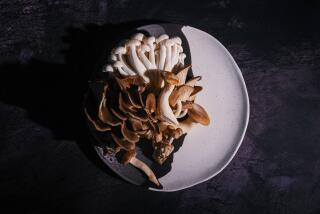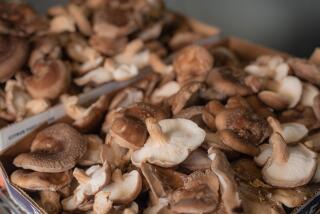Growing Your Own Cantaloupes
Flavor and aroma--that’s what home-grown cantaloupes are all about.
Only a small percentage of the population has ever sampled the luscious flavor and aroma of a cantaloupe left on the vine until fully ripened. Commercial varieties are sweet, but they are picked when far from peak ripeness--with great loss of flavor.
To experience a cantaloupe at its delightful best, you will have to grow your own. Many home gardeners avoid cantaloupes because they feel that cantaloupes require too much garden space. It’s true, they tend to sprawl in all directions, but there is a simple planting method that will allow a bountiful harvest within a 3-by-12-foot area.
To grow your own cantaloupes, keep in mind that they love warmth and require a warm, sunny growing site. There are also certain cultural practices that you should follow to assure that they achieve peak flavor.
According to Paul Thomas, former research director at Petoseed, the world’s largest producer of cantaloupe seeds, you should never over-water cantaloupes. Thomas, who has spent 43 years in cantaloupe and other warm-season vegetable research, warns that if cantaloupe plants receive too much water, the sugar content of the fruit will be diluted.
Thomas recommends that in most soils, the plants should be watered deeply only once a week; an extreme heat spell would require supplemental watering. Thomas says to avoid planting cantaloupes next to a law area where they will be watered by sprinklers.
As to other cultural practices, add lots of compost and other organic matter plus an all-purpose vegetable fertilizer when preparing the soil. Water thoroughly before planting.
Carefully follow directions on the seed packet as to planting depth. The traditional method is to plant melons in groups. Sow eight seeds in a circular area about 12 inches in diameter. Allow 5 feet of space between groups. When the young plants reach 2 inches tall, thin out all but the three strongest plants in each group. The vines will then grow and sprawl throughout the allotted garden area.
If space is limited, use the following method for producing a fine crop of cantaloupes in a 3 by 12-foot area. At the Petoseed trial grounds, they grow cantaloupes in 3 by 12-foot plots. In each plot, seeds are planted at 6-inch intervals centered down the 12-foot length. Then all but six or eight young plants are thinned to stand 18 to 24 inches apart.
Each week the plants are tucked back into the original planting plot so they form a mounded maze in which the melons mingle like eggs in a next. Plots produce about 30 cantaloupes.
You can increase the yield, speed up the ripening process and keep the melons clean by using a black plastic mulch under the vines. Just be certain to cut slits in the plastic to insure water penetration and proper drainage. And never use overhead sprinklers--this promotes mildew.
Thomas says cantaloupes are ready for harvest when the fruit breaks away from the stem with the tiniest of tugs. Thomas says you should not wait until the stem separates from the fruit by itself because when this occurs the cantaloupe is overripe.
There is a wonderful selection of cantaloupe varieties available to the home gardener. Thomas says that when he craves a cantaloupe he visits Petoseed’s test fields and picks either one of two varieties from the multitude grown there. The first is an unusual Mediterranean type cantaloupe called Gallicum. This melon originated in Israel and, although it looks like a regular cantaloupe, the flesh is a light green when ripe. And Thomas says that the flesh is sugar sweet--like eating candy. Thomas’ other favorite is a variety called Saticoy Hybrid, which features mouth-watering, sweet, yet mellow flesh.
Thomas says that a third variety, Bush Star, has a unique dwarf plant habit, produces delicious fruit and is a good choice for home gardeners to grow in large containers or limited space gardens.
To the above varieties, from my own experience, I would add two more. Burpee Hybrid has been around for years and it is still hard to beat. It produces large melons that average 4 1/2 pounds; the flesh is sweet and very juicy and the aroma is superb. Ambrosia Hybrid features large, aromatic melons that are sweet and juicy with a distinctive flavor not found in other melons.
Seeds for some of these varieties can probably be located at local nurseries. Seeds for Bush Star should be available at nurseries that carry Ferry Morse Seeds. Burpee Hybrid and Ambrosia should be easy to find at nurseries that stock Burpee Seeds, or they can be ordered by mail from Burpee Seed Co., 300 Park Ave., Warminster, Pa. 18991; phone (800) 888-1447. Seeds for Gallicum are available only by mail from Nichols Garden Nursery, 1190 N. Pacific Hwy., Albany, Ore. 97321; phone (503) 928-9280. Seeds for Saticoy Hybrid are available from Garden Trends Inc., 60 Saginaw Drive, Rochester, N.Y. 14623. All three of these mail-order firms offer free catalogues.






